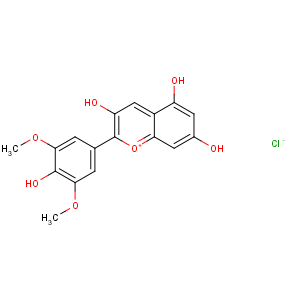Title: Malvidin Chloride
CAS Registry Number: 643-84-5
CAS Name: 3,5,7-Trihydroxy-2-(4-hydroxy-3,5-dimethoxyphenyl)-1-benzopyrylium chloride
Synonyms: 3,4¢,5,7-tetrahydroxy-3¢,5¢-dimethoxyflavylium chloride; enidin; primulidin; syringidin; 3,4¢,5,7-tetrahydroxy-3¢,5¢-dimethoxy-2-phenylbenzopyrylium chloride
Molecular Formula: C17H15ClO7
Molecular Weight: 366.75
Percent Composition: C 55.67%, H 4.12%, Cl 9.67%, O 30.54%
Literature References: Found as the diglucoside (malvin) in wild malve (
Primula viscosa All.,
Primulaceae) and as the monoglucoside in blue grapes: Willst?tter, Mieg,
Ann. 408, 122 (1915); Karrer, Widmer,
Helv. Chim. Acta 10, 5 (1927). Structure: Anderson, Nabenhauer,
J. Am. Chem. Soc. 48, 2997 (1926). Synthesis: Bradley, Robinson,
J. Chem. Soc. 1928, 1541.
Properties: Prisms or rhombic tablets, appearing red by transmitted light with a green luster when dry or with a steel-blue luster when in contact with solvent. Usually obtained as the mono- or dihydrate. The anhydr salt is very hygroscopic. Not melted at 300°. Sol in abs alc, giving a violet-red soln. Sparingly sol in water. Also sol in amyl alc. In methanol the substance is first sol with purple color, then begins to separate as red crystals which are violet by transmitted light.
Derivative Type: 3-b-Glucoside tetrahydrate
Synonyms: 3-(Glucosyloxy)-4¢,5,7-trihydroxy-3¢,5¢-dimethoxyflavylium chloride; enin; cyclamin
Molecular Formula: C23H25ClO12.4H2O
Molecular Weight: 600.95
Percent Composition: C 45.97%, H 5.53%, Cl 5.90%, O 42.60%
Properties: Synthesis: Levy
et al., J. Chem. Soc. 1931, 2701. Dark prisms with a green metallic shine, from alcohol + HCl. Sparingly sol in water, alcohol, glycerol. Practically insol in benzene, chloroform, ether.
Derivative Type: 3,5-Diglucoside
Synonyms: 3,5-Bis(glucosyloxy)-4¢,7-dihydroxy-3¢,5¢-dimethoxyflavylium chloride; malvin; malvoside
Molecular Formula: C29H35ClO17
Molecular Weight: 691.03
Percent Composition: C 50.40%, H 5.11%, Cl 5.13%, O 39.36%
Properties: Synthesis: Robinson, Todd,
ibid. 1932, 2299. Reddish-brown prisms or needles with a green shine from dil HCl, dec 165°.
Derivative Type: 3-Galactoside hemihendecahydrate
Synonyms: Primulin
Molecular Formula: C23H25ClO12.5?H2O
Molecular Weight: 627.97
Percent Composition: C 43.99%, H 5.78%, Cl 5.65%, O 44.59%
Properties: Bronze metallic needles or prisms from methanol + HCl. Bluish-violet by transmitted light. Very sol in methanol, ethanol, cold water, forming deep red solns; slightly sol in acetone. Practically insol in ethyl acetate.

